COLLECTING SANTA ANA's
By Jim "Spaceman" Sinsley
Reprinted from "Crown Jewels of the Wire", October 2006, page 32
I first became acquainted with insulators, as collectibles, when we got a new
couple into our newly formed Antique Bottle Club of Orange County (California)
about 1965. They were a really fun couple but I thought the guy, Glenn, was
strange because he collected insulators instead of bottles. My Dad was an old
time, retired employee of the local power company and his opinion of insulators,
as a collectible, was,,,,, well,,,, lets just say less than
flattering. I guess his opinion had sort of rubbed off on me.
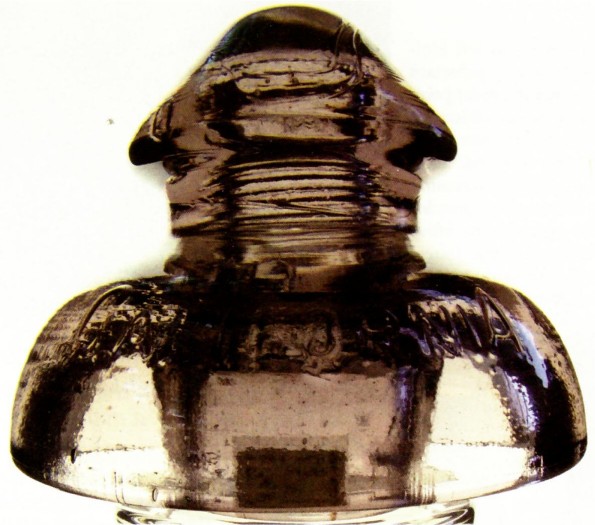
Then, about 1967, a friend and fellow Fruit Jar collector, Frank Peters, who
was staying at our house in Santa Ana, California while attending a bottle show,
gave us a very nice, beautiful SCA CD 178 CaliforniA - 303 / Santa Ana (shown
above). Well, how could one turn down such a thoughtful gift. Little did I know
at that time that I WAS an insulator collector. It just took 20 + years to
really surface.
With that first Santa Ana hanging around all those years and Santa Ana,
California being the city of my birth, it just seemed natural to specialize in
CD 178s when I finally decided to give in and actually collect insulators. Once
I had acquired about 20 of them I adopted the nickname SPACEMAN for myself. You
know, the 178s are nicknamed SPACESHIPS for their resemblance to Hollywood's
early idea of what a Spaceship would look like. I remember seeing something with
a similar shape in a Sci-Fi movie, I think it was "War of the Worlds"
or something like that.
There is not a lot known about the origins of these insulators but I will
attempt to put down here what I think I know about them. We know that HEMINGRAY
produced one type of CD 178 although it is not called a Santa Ana. It is
embossed simply HEMINGRAY - PATENT MAY 2 1893 in a sort of "script"
style. They, of course, have the sharp drip points. All known examples are Aqua
or Blue Aqua and are a bit pricey as they are not common.
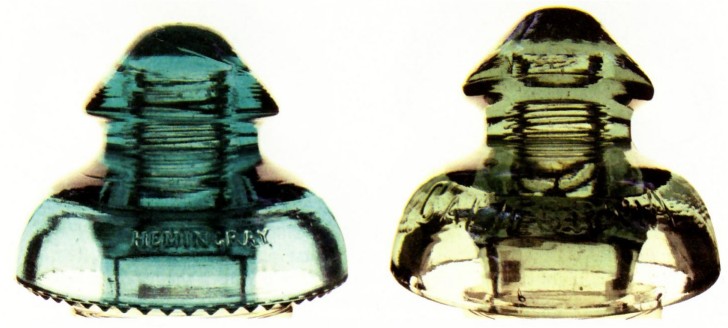
The next group include those we are certain were made by the California Glass
Insulator Company or California Glass Company, probably the latter. There are
examples with the CaliforniA (notice the capital A on the end) name embossed
plus 303 / Santa Ana and some without the CaliforniA but with tell tale features
such as mold style, color, glass characteristic, etc. that are unmistakable.
These are found in some of the typical California colors such as: Purple, Smoke,
and Sage Green & Light Yellow Green. I have a Smoke colored example that has
a bit of Yellowish appearance in good back lighting.
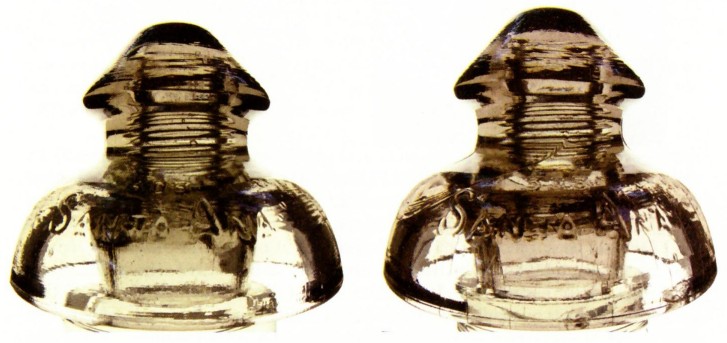
Both the smoke colored CD 178 on the left; and the light amethyst one on the
right,
are embossed only: 303 / Santa Ana. They lack the word:
CalifomiA.
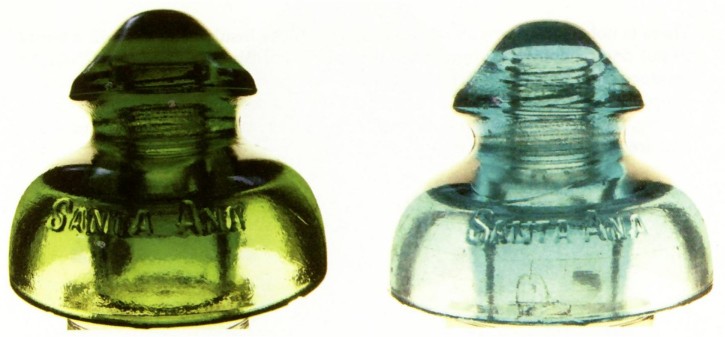
In the next group are those that have only Santa Ana embossed on the skirt
that we suspect were made in Elmer, New Jersey because of the colors in which
they are found and glass appearance. These pieces, that range from Light to Dark
Aqua to Teal Aqua, Light Blue to Blue and a wide range of Green shades from
Yellow Green to Olive Green to Dark Olive Green, have colors similar to pieces
marked or known to have been made by companies that operated in Elmer such as
Novelty, Sterling or Harloe. These are further identified as Elmer by the
"Elmer Ring" at the top of the pin hole.
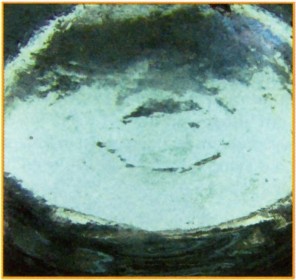 |
Man Santa Anas have a circular
ring embossed in the glass at the top
of the pin hole.
Collectors think the mark provides a clue that those insulators were made
at one of the glass factories in Elmer, New Jersey.
|
We are pretty sure that BROOKFIELD made some CD 178s, even though none have
the name embossed, as they advertised them and the color & appearance of the
glass in some examples leads to that assumption. It is suspected that BROOKFIELD
made their pieces in molds acquired from one of the company's whose assets they
acquired and who had done business in Elmer, N.J. The MOLD characteristics are
the same except for the absence of "Elmer Ring" but the glass color
and appearance is not typical of Elmer but virtually identical to marked
BROOKFIELD pieces. These pieces are all in the Aqua to Blue color range.
Then there are the [Santa Ana blotted out] and No Name pieces. I believe
these are one and the same but because of the texture of the glass in the
embossing area one can't see the blotted out lettering which is QUITE faint on
many of the blot
outs. There are some very specific, distinct mold features that are, in my
opinion, proof that they were made in the same mold and by BROOKFIELD as they
lack the "Elmer Ring". However, I believe the separate listing may be
correct as, even with very close scrutiny, the blotted out embossing can't be
seen.
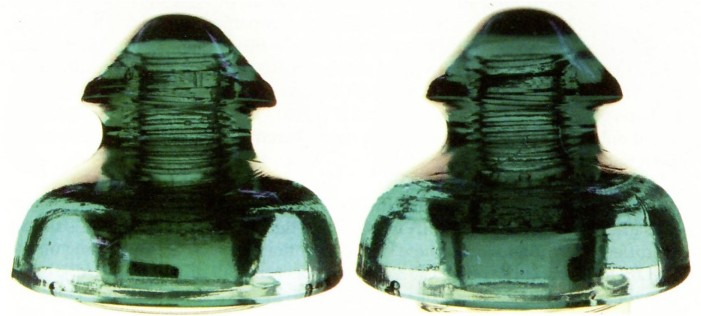
Above: Two Brookfield-appearing CD 178's. The one on the left shows a
blot-out of the
word "Santa Ana"; while there's no evidence of a
blot-out showing on the insulator at the right.
Speaking of MOLD characteristics, all known examples, other than the
HEMINGRAY pieces, are found with two different base types. The McDougald's
information lists SB (Smooth Base) and RB (Rounded Base). I believe we are all
familiar with SB as meaning without Drip Points, Embossing or some such feature
on the base. RB is a bit more confusing. The term or word ROUNDED conjures a
mental picture of something ROUND while in actuality that is only part of the
intended description. RB also is meant to describe the "mold seam (that)
extends to the inside edge of the base". On some styles of insulator, such
as CD 162 HAMILTON, CD 134 No Name - Canada, CD 296 Locke, etc., the side mold
seam extends down the skirt and makes a large radius transition to the base and
the mold line continues uninterrupted to the inside of the skirt where it meets
a mold seam that goes around the INSIDE of the skirt. With the typical SB, a
mold seam runs around the OUTSIDE of the skirt and the side seam stops there.
RB (Rounded Base) is quite confusing when one views the FLAT smooth base with
the Mold Line Across Base {MLAB} (as I call it) on all the CALIFORNIA and some
other 178s that are listed as RB. The side mold seam intersects with a faint
mold seam on the OUTSIDE of the skirt then continues across the FLAT base to the
more prominent mold seam on the INSIDE of the skirt. The mold seam on the
outside of the skirt is very subtle and easily missed. I greatly admire and
appreciate the McDougalds for their contributions to the hobby but I will
continue to disagree with their description of the base of some CD 178s. To me,
there are SB (Smooth Base) and SB {MLAB} (Smooth Base with Mold Line Across
Base) 178s. I find it very interesting that (as far as I know) this combination
of features (Smooth Flat base with {MLAB}) is found only on the CD 178s and that
some are definitely made by CALIFORNIA and others are not. Who made the other SB
{MLAB}? Did someone acquire CALIFORNIA's molds or did CALIFORNIA obtain someone
else's?
All of the Blot Out / No Name pieces, which are SB {MLAB}, appear to have
been made in the same mold & are about the same color, Dark Aqua and Dark
Teal Aqua. They do NOT have the "Elmer Ring". They have many, if not
all, of the same mold characteristics as the Santa Ana SB {MLAB} but these are a
lighter shade of Aqua. It seems pretty easy to say that all of these were made
in the same, or VERY similar, molds but by different companies at different
times and/ or locations. While the CaliforniA pieces have the SB {MLAB} feature,
there is no similarity to embossing style or mold characteristics. I would say
that no one used the CALIFORNIA molds nor did CALIFORNIA use some one else's
molds except perhaps the base plate. However, I find it WEIRD that this SB {MLAB}
feature is found only on one CD and that at least two different companies could
have made them with different molds.
If I have to guess, I would say that the Base Plates of all SB {MLAB}
insulators are the same, whether CALIFORNIA made or not, but the upper part of
the insulators are different. In other words, there is no correlation between
the embossing on the CALIFORNIA and the other CD 178s. I suspect that all of the
SB{MLAB}, other than the CALIFORNIA made pieces, were made by BROOKFIELD. They
DO NOT have the "Elmer Ring".
Based primarily on mold characteristics but also color differences, I would
say that at least two different companies made the SB 178s. The darker Yellow
Greens and Olive Greens and perhaps other colors were in all probability made by
NOVELTY (or some other Elmer company) while others with different colors and
dissimilar mold characteristics, primarily at the petticoat or inner skirt, were
probably made by Sterling or Harloe (or some other Elmer company).
Now that we have explored the insulators themselves, and their probable /
possible origins, it is interesting to note that the name was probably
determined by the style's first use in a project for power distribution, about
1893, along the Santa Ana River Valley in Southern California to Redlands. They
were designed to carry 5,000 volts, but were not abandoned when the line was
upgraded to 10,000 volts in 1896.* I suspect, although there is no real proof
that I know of, that the project was large enough that more than one
manufacturer was used simultaneously to supply the first project. I believe that
HEMINGRAY was among the first producers of the style and perhaps one or more of
the Elmer companies also. I am confident that the style was popular enough and
marketed for a long enough period of time that several companies got into the
act. The original project in the river valley would have been completed before
the California company was in existence. There have been a large number of
CaliforniA and non-California pieces found in the San Joaquin Valley in
California and others in the Mid-West. I would sincerely appreciate any
documentation of exactly where else these were used and at what period of time.
I currently have about 40 CD 178s in my actual collection, no absolute
duplicates as I include any and all color and embossing variations. There are
some colors included that defy description. One, a CaliforniA - 303/ Santa Ana
in a sort of pastel, Sagey light Yellow Green, is unlike any other California
color seen. (Thanks Tim Wood)
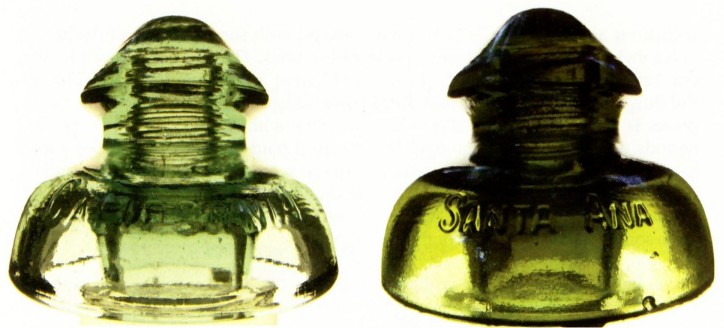
Left: A "limey" color for a sage green California.
Right: A strong
example of a true or dark olive green CD 178.
The ones listed as Light Blue and the Blue ones are quite different
in appearance even though the names don't indicate that. The range of Aqua is
very wide as is the Green range. The toughest colors are not directly in line
with scarcity, price or desirability. The SMOKE pieces are scarce & highly
sought out, especially if they have NO HINT of purple. LIME Green may be the
figment of someone's imagination. I have one I call LIME but it is just barely
in that spectrum. (I would pay some serious cash for a true, brilliant, no
questions asked LIME Green piece) There are a number of pieces that have popped
up recently that are called OLIVE, and they are just barely into the Olive
spectrum, but there is only a handful of TRUE Olive Green or Dark Olive green
pieces to be had. Be careful and discriminating when buying an OLIVE green
piece. I have purchased several that were advertised as Olive and I thought they
were Olive until I acquired a REAL Olive example. Side by side there is a BIG
difference. Yellow Green is NOT Olive Green!!! (At least when it comes to CD
178s)
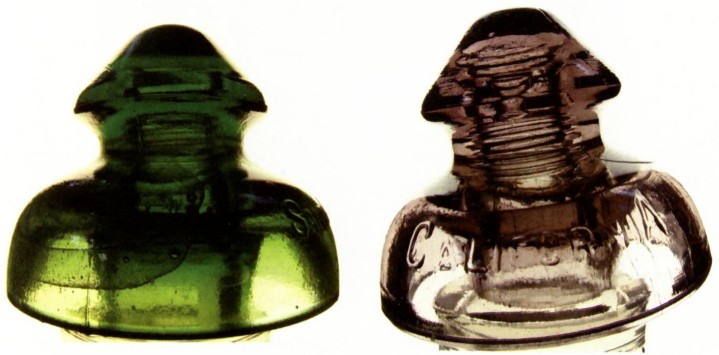
Left: Graphite swirl. Right: CD 178 "Leaner".
Inclusions are RARE in CD 178s. I have several with some amount of Amber or
Olive swirls and one with teeny specks of fire brick. (Thanks Tim Wood) I have
one Yellow Green with what looks like a ribbon of graphite in the skirt. (Thanks
Bill Burger & Bill Reid) If viewed at the correct angle, one of my
borderline Olive pieces is actually 3 tones, Yellow Green / Olive with Amber and
Aqua streaks. Sounds delicious but it is too dark to see well. I paid big bucks
for this one in a catalog auction; it looked good in the pictures. It seems that
an inordinate number of Santa Ana CD 178s are "leaners". (Thanks Bill
Reid) I have a couple where the skirt touches the table and one even raises the
inner skirt off the table. A few others have some "under pour" but
nothing radical.
If you have an example that you believe is unusual I would enjoy hearing
about it and seeing it if only by picture. If any unusual pieces are available I
am always interested in acquiring additional pieces for my collection. If you
have input, questions, theories, information, etc. I am always interested in
hearing from others.
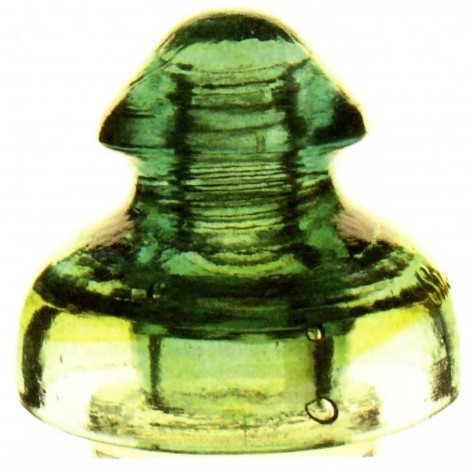
Amber swirls and various depths of color give
this "spaceship"
out-of-this-world character.
Jim Sinsley Jim@SinsleyStuff.Info
P.O. Box 1407 Spirit Lake, ID 83869
Phone:
208-623-2848
If you have a specialty I suggest that you write an article about it for
Crown Jewels. It forces you to scrutinize the insulators, dig for information
and you will learn a lot from the experience. Others in the hobby will also
benefit.
* Multipart Porcelain Insulators, by Elton Gish, pages 6-7
| 